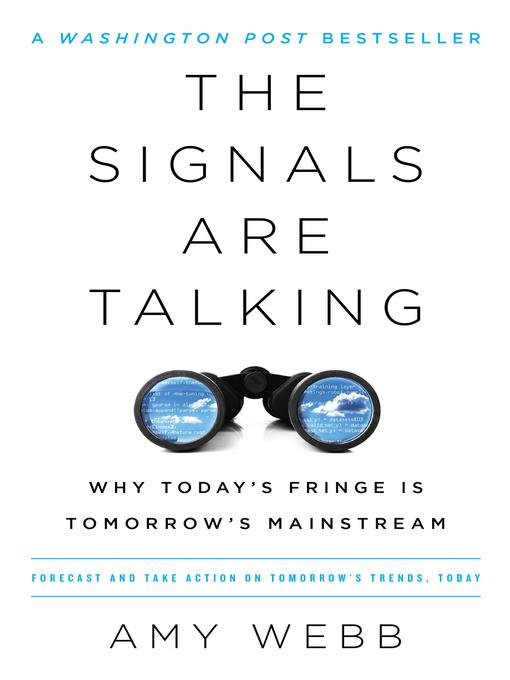
The Signals Are Talking
Why Today's Fringe Is Tomorrow's Mainstream
کتاب های مرتبط
- اطلاعات
- نقد و بررسی
- دیدگاه کاربران
نقد و بررسی

October 17, 2016
Trends can be profitably predicted, according to this windy treatise on business futurism. Webb, founder of the Future Today Institute consultancy, insists that prognosticating is a “learnable skill” and lays out a labyrinthine, acronym-heavy conceptual framework for pondering the future, featuring three rules, six instructions, 10 “sources of change,” a six-part “CIPHER model,”and a six-part “F.U.T.U.R.E test” to “pressure-test any strategy created to address a technology trend.” It all amounts to a tangle of vague truisms—rule one says, “The future is not predetermined, but rather woven together from numerous threads that are themselves being woven in the present”—that leave the impression that futurology is still a dark art navigable only by hiring experts such as the author. Webb’s own predictions are sometimes bizarre—she asserts that drones will make America dependent on imported food and that “pods” hooked to maglev trains will replace airplanes—but when she’s predicting trends in digital technology, which is most of the time, the future sounds both grandiose and boring. (Google, she reports, is “creating a ubiquitous exo-brain... that could anticipate my every need” and will eventually become “some kind of digital life assistant.”) Webb’s futurism is not compelling, but her insightful retrospectives on why some innovations succeeded and others failed make for an engaging study of technical trends of the past.

October 1, 2016
How to forecast emerging technological tends.Dont confuse the trendy with trends, warns Webb, founder of the Future Today Institute. Unlike hip, shiny objects, trends persist and can change everything. They include self-driving cars, artificial intelligence, and other phenomena that will deeply affect our lives. Too often, writes the author, leaders ignore the signals [of emerging trends], wait too long to take action, or plan for only one scenario. In this useful guide, she offers a systematic way to interpret events and foresee how they will shape the future. In brief: watch fringe areas, where new ideas emerge; uncover hidden patterns; determine whether a pattern is a trend; calculate its arrival time; plan scenarios to act on the trend; test your scenarios. Her detailed explanation of these simple-seeming steps is based on many years of experience advising organizations and will undoubtedly help leaders contemplate what lies ahead. The author makes clear how difficult it is to recognize forthcoming changes in an era when change is commonplace. Also, we tend to underplay the significance of something when it is not significant to our immediate frame of reference. Companies like Nintendo have listened to the signals, adapted to change, and lasted since the late 1800s. Digital Equipment Corporation, once a leading vendor of computer systems, failed to anticipate personal computing, with disastrous results. Similarly, BlackBerry failed, its products eclipsed by new trends. Webbs stories of these companies and her close examination of current trendiness help readers understand how certain fringe thinking is shaped by diverse external forces (wealth distribution, education, government, etc.) into genuine trends. We know Uber represents a trend because it leverages our basic human needs and desires in a meaningful way and aligns our human nature with emerging technologies and breakthrough inventions, she writes. Webb provides a logical way to sift through todays onslaught of events and information to spot coming changes in your corner of the world.
COPYRIGHT(2016) Kirkus Reviews, ALL RIGHTS RESERVED.

November 15, 2016
Webb founded the Future Today Institute and is renowned in the world of futurism. As mind-blowing as futurism can beand Webb provides several brain-bending future possibilitiesthis book is mainly aimed at business- and investment-minded readers. Her methodology centers on a six-step funnel that gathers and processes information from the technological fringe; she then offers advice about timing and on imagining and testing various scenarios. A key step is to identify hidden patterns by spotting contradictions, inflections, practices, hacks, extremes, and rarities. Webb also counsels readers on how to analyze technology's impact on wealth distribution, education, government, politics, public health, demographics, economics, journalism, and the environment. She describes how treatments such as plastic surgery, anesthetics, and antidepressants moved, over time, from the fringe to the mainstream. And she contrasts the way Nintendo consistently looked ahead and evolved, while the once-massive Digital Equipment Corporation predicted in the 1980s that personal computing would fail. Readers may grow weary of the avalanche of information, but Webb's stellar reputation in this red-hot field should generate demand.(Reprinted with permission of Booklist, copyright 2016, American Library Association.)

























دیدگاه کاربران